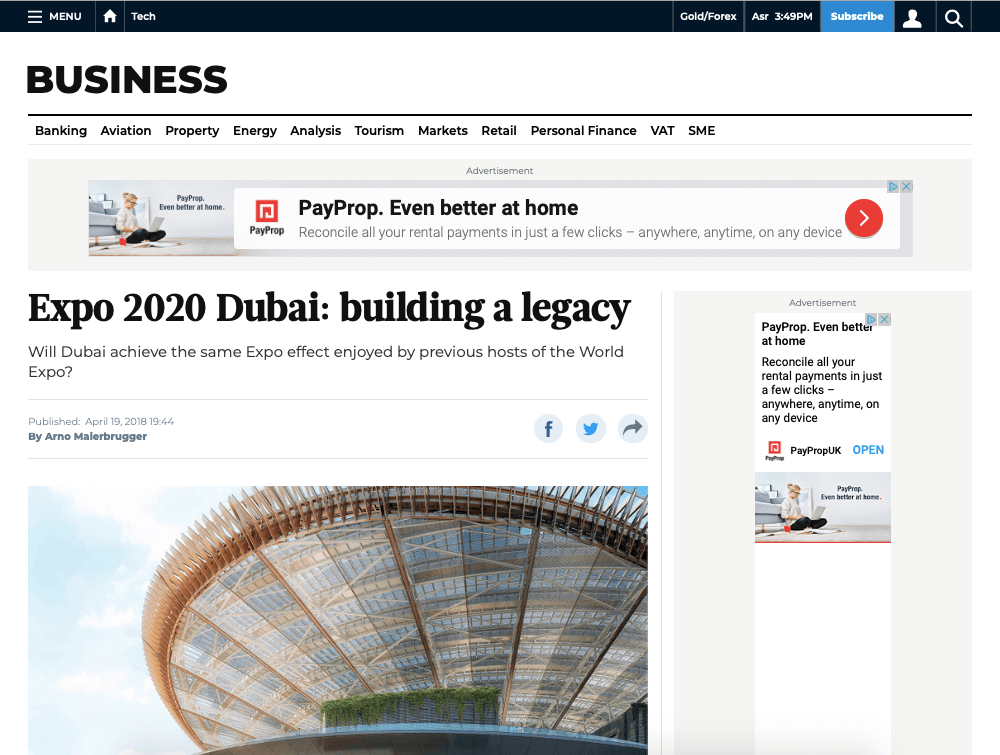Any well-orchestrated World Expo is basically meant to be a huge marketing event to create awareness, lure investments and broadly spur the economy. But the big question is, to what extent will the high expectations be met? Looking back, the last World Expos in Milan in 2015 and Shanghai in 2010 all had a noticeably positive effect on the real estate market. In Milan, the city’s land department reported that residential sales on a principally mature market still grew by 6.8 per cent ahead of the Expo, powered by new developments in the city’s inner districts. According to Italian property market survey firm Scenari Immobiliari, the “Expo effect” is seen to remain lingering at least five years after the exhibition, with prices expected to rise up to 14 per cent until 2020.
Shanghai, in turn, saw an even broader effect before and after the Expo on retail, residential and hospitality property, along with a general construction boom after the exhibition that took advantage of the highly improved infrastructure. An entire riverfront district where the Expo was staged opened for redevelopment over 5 sq km, and high-end office buildings and residential properties were built and an entire new urban neighbourhood materialised.
The China Pavilion at the World Expo 2010 in Shanghai
“The effect of the Expo in Shanghai was really noticeable,” said Lina Wong, former head of Colliers International’s Shanghai office, who studied the effects of the Expo meticulously. “It led also to a boom in residential property leasing, with vacancy rates for high-end residential property and serviced apartments falling sharply during the Expo, while the city now boasts new building architectural complexes and landmark architecture attractive to visitors and investors.”
For host cities, the Expo has been a catalyst for accelerating urban development and infrastructure, said Vicente Loscertales, general secretary of the Bureau of International Expositions in Paris, which chooses the Expo host. “[It has a] powerful impact on a city’s branding and international image that attracts investors on a number of levels.”
This leads to questions on the real estate impact of World Expo 2020 in Dubai, an event that has generated an estimated $50 billion (Dh183.62 billion) in direct and indirect investments, with $8 billion being allocated to transport and infrastructure projects alone.
Experience from previous hosts shows that the Expo’s impact is a three stage process:
1. Pre Expo: Infrastructure development ahead of the expo, such as new mass transit connections, is the main driver for an upswing in real estate before the event, encouraging property buyers and investors as the economy generally warms up as a direct effect of new and improved urban mobility networks, with significant anticipated appreciation once all infrastructure is up and running.
2. During the Expo: An expected influx of more than 25 million visitors over the roughly six months of the Expo 2020 and more than 300,000 new jobs to be created, in addition to around 180 exhibiting countries and international organisations attending the event, means large opportunities for hotels, serviced apartments and other residential properties. Rental yields for premium apartments could even double from the current average of around 5 per cent in the city, brokers say, particularly in popular and sought-after locations in proximity to the Expo site, including Dubai Marina, Jumeirah Lakes Towers, Jumeirah Islands and Jumeirah Golf Estates.
“Of course, construction and hospitality staff require to stay somewhere, as do business people who will visit during the exhibition,” says Russell Midgley, director of Aspen Woolf Real Estate, a property broker with branches in London and Dubai.
“Investors looking for long-term growth potential should consider an immediate purchase of a Dubai property and take advantage of the healthy rental market. Being prepared to hold this real estate through Expo 2020 and beyond will reap the biggest returns on investment, as prices are expected to rise in the long term, not to mention the rental income gained during this time.”
3. Post Expo: Real estate near the Expo site will continue to benefit from investments in infrastructure and from new urban developments close to the site, such as Dubai South, as well as from the proximity to Al Maktoum International Airport. Moreover, after the Expo, the pavilions will make way for the development of an entirely new suburb called District 2020, with 65,000 sq m of residential space and 135,000 sq m of commercial and office space.
“There is general consensus that those factors will increase investment in the property market as they strengthen confidence and increase real estate values, even after the exhibition has ended in 2021,” says Midgley.
The Expo 2015 Gate in Piazza Castelo, Milan, Italy. Prices in Milan are expected to rise up to 14 per cent until 2020 as a result of the Expo
Kalpesh Sampat, managing partner of Gulf Sotheby’s International Realty in Dubai, points out that there has been a notable uptick in the ready segment, which is expected to further strengthen in the run-up to the big event.
There are three main reasons for this: population growth, attractive yields and the influx of new buyers and investors.
Population growth
The growth in population in Dubai is already outpacing new residential supply by two to one since last year, and this will only intensify as the Expo draws near. The fact that over 58,000 units are scheduled to enter the market between 2019 and 2020 may offset any population surge linked to Expo 2020, but not what comes after that. Dubai Municipality predicts that the city’s population will nearly double from 2.8 million today to five million by 2030, indicating the need for no less than a doubling of the city’s housing stock. Most of the demand is expected to come from the lower to middle-income bracket, meaning that house price spikes in more affordable communities are foreseeable in the medium to long term.
Attractive yields
Analysts believe that the attractive yields in Dubai of 8-9 per cent on smaller properties and 6-7 per cent on mid to large properties are here to stay on the back of stable demand.
New buyers, investors
The Expo 2020 will inevitably bring a wave of new potential buyers and investors to the market who might not have thought of investing in Dubai before, but would come to enjoy the cosmopolitan flair of the city and even decide to live here in the long term.
Another important factor underpinning the confidence in the property market is that despite the introduction of the value-added tax (VAT) in the UAE at the beginning of the year, there are still no taxes on capital gains, property appreciation, salaries or rental yields, and there are no plans to introduce such on the back of stabilising oil prices, Sampat notes. In addition, property investors are on the safe side as they can now put the money for property transactions in a secure escrow account and enjoy limited restrictions and minimal regulations and licensing requirements for opening bank accounts and businesses in Dubai.
Moreover, anyone who buys property worth at least Dh1 million is eligible for a renewable investor residency visa, along with immediate family members.
Faisal Durrani, head of research at property consultancy Cluttons, enthusiastically describes the Expo 2020 as a “catalyst” for the city‘s property market and “a shining light on the horizon” for real estate investors. He even lauded the new VAT, reasoning that while it makes living generally more expensive in Dubai, it would also result in better payment plans with tax refund options for buyers of Dubai real estate.
Sapna Jagtiani, real estate analyst at S&P Global Ratings, says the expected arrival of 25 million visitors and new residents alone is already a major driving for the economy and the property market in particular.
“The mega-event will prove itself as a crucial economic factor for Dubai,” says Jagtiani. “It has the potential to end the slowdown of the property market due to its positive economic effects on the emirate.”
However, she points at the potential risk of “overbuilding”, which should be avoided at all costs to prevent oversupply and its lingering effects that would be felt well beyond 2020.


